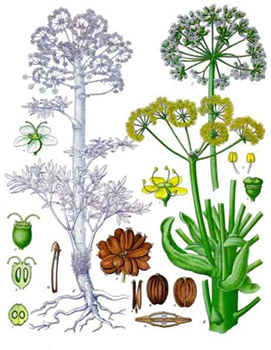Asafoetida Ferula asafoetida

Koehler's Medicinal Plants 1897
- Common Names
- Asafoetida root , devil's dung, food of the gods, hing, narthex
- Botanical Name
- Ferula asafoetida
- Family
- APIACEAE
Medicinal Uses & Benefits of Asafoetida Root
![]() How to Use|
Side Effects |
Plant & Garden|
How to Use|
Side Effects |
Plant & Garden|
- Medicinal Uses: * Ayurvedic
* Cholesterol
* Digestion
- Properties: * Abortifacient * Antispasmodic * Nervine * Vermifuge
- Parts Used: Resin from roots
How to Use: Asafoetida
Asafoetida is useful as a digestive spice that has the additional benefit of lowering cholesterol and reducing gas. The pungent oil can be using to repel insects. Asafoetida was one of the most commonly prescribed herbs in the 19th century in the treatment of hysteria and for many symptoms associated with mood swings and depression,or in ayurvedic terms "Asafetida is a grounding herb that can therefore balance an overactive, over emotional, turbulent system".
Preparation Methods & Dosage :Traditionally used as powder or tincture. The pale yellow or orange-yellow essential oil, occasionally used in aromatherapy in place of garlic, is not a substitute. Used in the Ayurvedic formula Unmadnashak Ghrita, cardamom, along with brahmi, gardenia, asafetida, and ghee. 2
 In the Kitchen: Asafoetida is used as an ingredient in Worcestershire sauce, many cooks enjoy adding a pinch of asafoetida powder while stir-frying meats and vegetables. This spice has a pungent aroma that is more persistent than garlic.
In the Kitchen: Asafoetida is used as an ingredient in Worcestershire sauce, many cooks enjoy adding a pinch of asafoetida powder while stir-frying meats and vegetables. This spice has a pungent aroma that is more persistent than garlic.
Ayurvedic Medicine
 Hing warms and corrects excess vata and kapha. The strong, sulfur like smell gives rise to the common name devils dung. Like most smelly herbs it nurtures the earth element and enhances stamina. 2
Hing warms and corrects excess vata and kapha. The strong, sulfur like smell gives rise to the common name devils dung. Like most smelly herbs it nurtures the earth element and enhances stamina. 2
Asafoetida Side Effects: The uncooked herb can cause nausea and vomiting. Using asafoetida over long periods may cause throat irritation, gas, diarrhea, and burning urination. This herb should be avoided during pregnancy. It may affect the menstrual cycle, and it is known to induce miscarriage.
Plant Description
- Flowers:umbels of white flower
- Plant: Perennial, grows up to 6 ft tall
- Leaves:Composite
- Root: Fleshy taproot
- Harvesting:Asafoetida produces a gum gathered in summer from the roots of plants at least four years old (if a plant is not a minimum of four ^ears old, its gum is considered worthless). The oldest plants are the most productive. The stems are cut off, and successive slices are made through the roots. The gum wells up and is collected after it has hardened.
- Distribution: native to Afghanistan, Iran, and Pakistan
Regional Traditions :Ayurvedic * Middle East *
- Asafetida � A Grounding Herb American Botanical Council
- Khalsa, Karta Purkh Singh, Michael Tierra. "The Way of Ayurvedic Herbs", Lotus, (2008)
With both pungent and healing activities, asafetida is used for digestive, nervous, circulatory, and respiratory conditions. It is used as a stimulant, carminative, analgesic, aphrodisiac and fertility enhancer (See HC 051164-432), antiseptic, and antispasmodic.










